Mercury and lead blood concentrations in pregnant women from 10 caribbean countries
Abstract
Maternal mercury (Hg) and lead (Pb) blood concentrations were measured in a total of 442 samples taken from pregnant and delivering women in 10 Caribbean countries. Hg was detected in all 10 countries with the geometric mean ranging from a low of 0.83 μg L−1 (Jamaica) to a high of 3.13 μg L−1 (Grenada). When compared to comparable U.S. and Canadian data, Hg concentrations in Caribbean women are on average more than 2 times higher. With the exception of St. Kitts & Nevis, Pb was detected in at least one of the samples taken from the other 9 countries with two countries–Grenada and St. Vincent – having Pb detected in ≥60% of those sampled. In these two countries, the Pb concentrations ranged from a low of 1.17 μg dL−1 (Grenada) to a high of 1.98 μg dL−1 (St. Vincent). Compared to comparable U.S. and Canadian data, Pb concentrations in Caribbean women are generally higher than that measured in North America. This study confirms that neonates in the Caribbean are being exposed to both Hg and Pb and highlights the need to implement surveillance programs that continuously monitor, intervene, and evaluate the levels of these toxic elements to ensure that they are reduced as far as possible.


 Please wait while we load your content...
Please wait while we load your content...